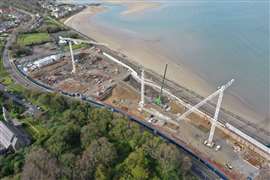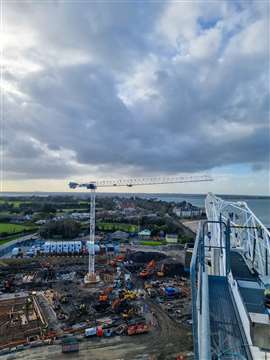Raimondi towers in Dublin
09 August 2023
Irish Cranes & Lifting, Raimondi’s official agent in Ireland, has deployed four Raimondi MRT234 flat top tower cranes for the construction of a new mixed-use development in Howth, a suburb of Dublin, Ireland.
 Each crane had to obtain specific permits for the site. (Photo: Raimondi)
Each crane had to obtain specific permits for the site. (Photo: Raimondi)
The Claremont development will comprise more than 500 residential units, as well as retail and commercial space.
Installed between March and April 2023, the cranes are onsite with jib lengths ranging between 44 and 60 metres, and heights ranging from a minimum of 37.5 metres to a maximum of 52.8 metres. All of the cranes, erected at a final configuration, are equipped with a hoist gear of 55 kW, and can lift at a maximum speed of 120 m/min.
 View from the top: The cranes were installed between March and April 2023 and will remain on site until the project is completed. (Photo: Raimondi)
View from the top: The cranes were installed between March and April 2023 and will remain on site until the project is completed. (Photo: Raimondi)
“Irish Cranes is proud to play a role in this pivotal project by supplying four Raimondi MRT234 flat tops to one of Ireland’s largest construction companies, Walls Construction.
“Our continued work with Walls demonstrates the strength of a long-standing partnership; we are pleased to support them on this landmark development,” said Robert Coffey, director general, Irish Cranes.
Rail requirements
Claremont, developed by Marlet Property Group, is located along a section of the Irish Rail network. Detailed studies of the positioning and operational procedures of each machine were required.
As per Irish Rail requirements, prior to installation, each crane had to be fully insured, obtain specific permits, as well as a licence agreement. In addition, once erected, each machine underwent a third-party independent inspection.
“From an operational perspective, during the installation procedures we had a series of guidelines to observe, including the supporting mobile crane allowed to slew only by 180 degrees. We had to install the cranes in parallel to the train tracks to avoid any component, including the counter ballast, oversailing the railway line. Worth noting is that a zoning of three metres away from the critical infrastructure has been permanently set for the entire site,” Coffey explained.
“In terms of technical challenges, to align with the existing regulations, all machines have been derated to 75 % of their maximum lifting capacity, and one of the jibs has been shortened to avoid interference with a communications mast on the rail line,” Coffey continued.
The four flat tops will remain onsite until the project is completed.
STAY CONNECTED


Receive the information you need when you need it through our world-leading magazines, newsletters and daily briefings.




